The NVIDIA SHIELD Android TV Review: A Premium 4K Set Top Box
by Ganesh T S on May 28, 2015 3:00 PM EST- Posted in
- Media Streamer
- Home Theater
- TV
- 4K
- Shield
- NVIDIA
Graphics Performance
While the SHIELD Android TV and the underlying Tegra X1 SoC are by no means slouches on the CPU side of matters, ultimately NVIDIA is still just another ARM Cortex implementer. On the other hand when it comes to GPUs, this is where NVIDIA truly shines. As NVIDIA is first and foremost a GPU company, and as a design philosophy always invests more time and die space into GPUs than any other SoC builder (save perhaps Apple X-class SoCs), they have always led the pack on GPU performance. And with the Tegra X1 packing a 256 CUDA core implementation of the very potent Maxwell GPU architecture, an estimated 1GHz clockspeed, and all the power and cooling it needs to keep from throttling, all of the ingredients are in place for a very strong showing from NVIDIA for GPU performance.
If there’s any real downside for NVIDIA and the SHIELD Android TV here, it’s that the Android GPU benchmarking situation hasn’t really caught up with what their GPUs are capable of. The standard benchmarks work, but game benchmarks are virtually non-existent, even in the AA and AAA games NVIDIA has helped bring over to the Android/SHIELD ecosystem. So we can’t for example look at the performance of The Talos Principle in the same way as we can the PC today.
Anyhow, we’ll start off with 3DMark’s Ice Storm Unlimited benchmark.
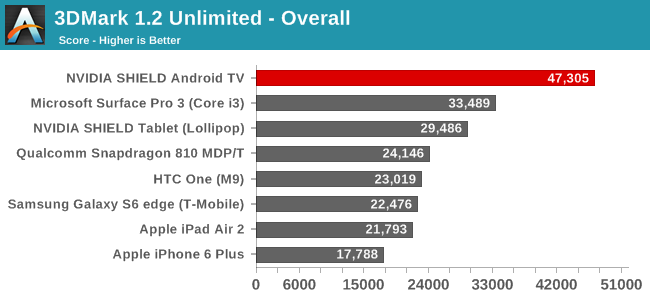
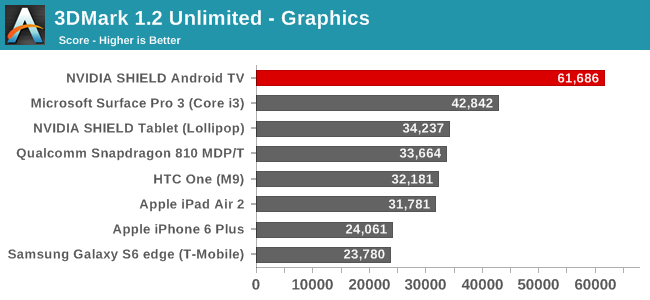
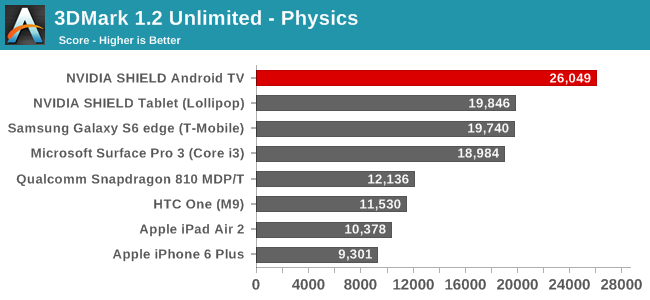
The results here pretty much speak for themselves, especially in the all-GPU graphics sub-score. SHIELD Android TV is 50% faster than the Surface Pro 3 and almost twice as fast as other devices like the iPad Air 2 and the last-generation SHIELD Tablet. Graphics workloads tend to be the most punishing from a heat and power standpoint, and hence are the most likely to get throttled. This really lets the SHIELD and its SoC open up here. At the same time, even in the physics score and the composite overall score, the SHIELD is well in the lead thanks to this combination of factors.
Up next we have BaseMark X 1.1.
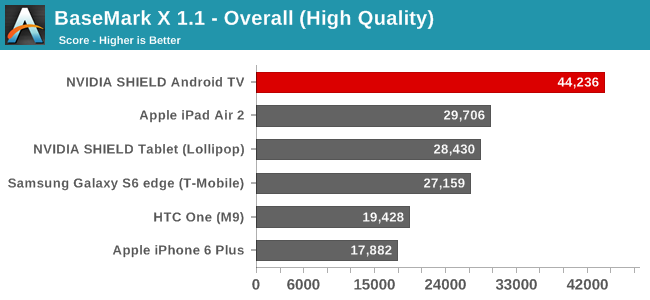
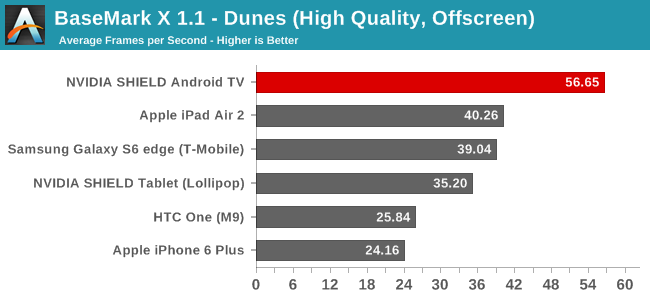

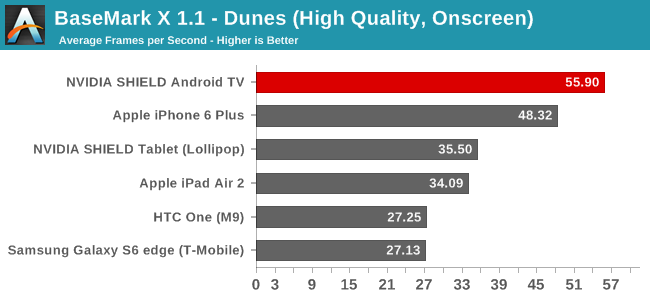
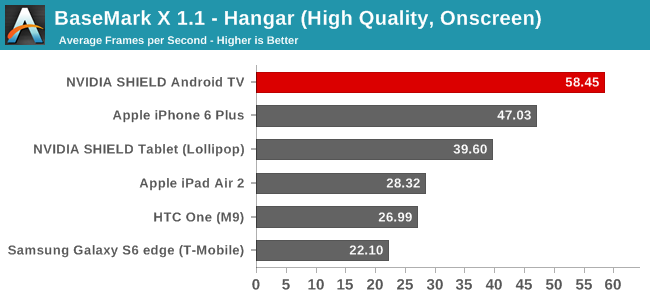
Once more it’s a clean sweep for the SHIELD. Apple’s iPad Air 2 tends to be the second-place finisher, thanks to Apple’s own significant investment in GPU resources, the SHIELD gets yet more resources and the power to fully exploit them. With all of that said, the one thing that does surprise me a bit here is that even the SHIELD can’t crack 60fps on Dunes and Hangar; BaseMark X will likely take one more generation before its tests can be completely beaten.
Our final GPU benchmark is GFXBench.

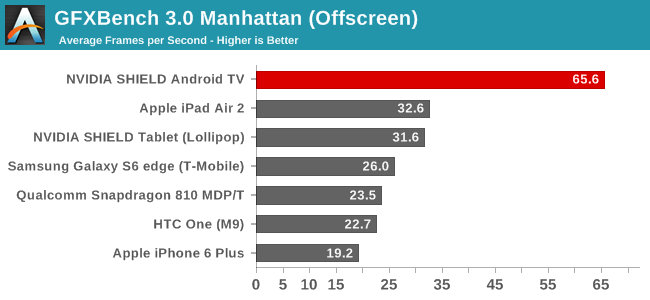
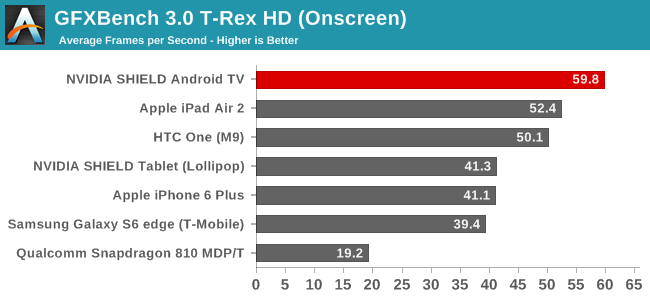
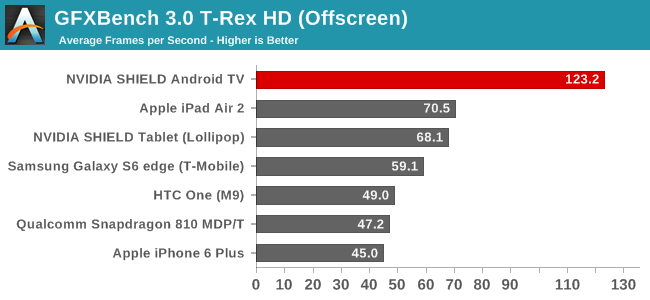
Starting first with the benchmark’s high-level tests, we once again find the SHIELD well in the lead. Of particular note here, the SHIELD Android TV becomes the first Android device to break 60fps on Manhattan, something that as recently as a generation ago seemed impossibly far away.
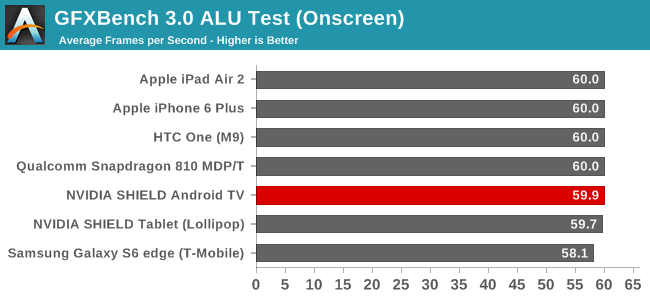
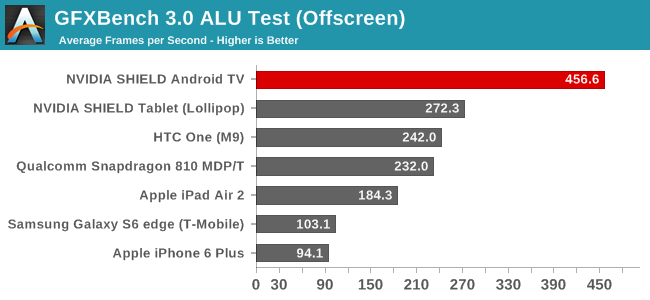

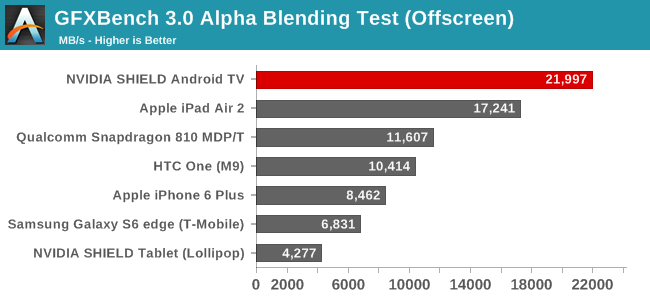
The low-level tests meanwhile offer us an interesting look at SHIELD and Tegra X1 that the high-level tests don’t provide. The ALU test for example drives home the point of just how much in the way of shading resources Tegra X1 has at its disposal (at least when unrestricted), and is a big reason why the SHIELD is doing so well here. On the other hand while NVIDIA still takes the top spot in alpha blending, the lead over the iPad Air 2 isn’t nearly as great, thanks in large part to the iPad’s relatively large 128-bit memory bus. Ultimately SHIELD doesn’t struggle here, but it’s an interesting point of comparison since it shows one of the only cases where SHIELD isn’t a run-away winner, and what kind of graphics workload may eat into its otherwise ridiculous advantage.
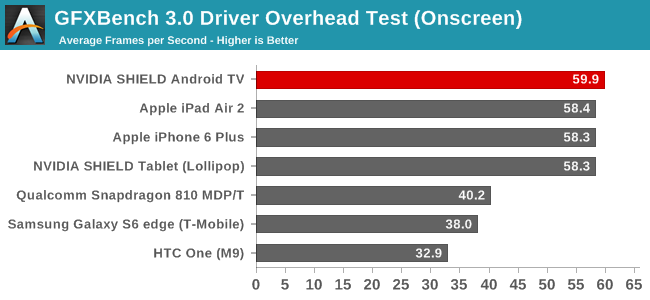
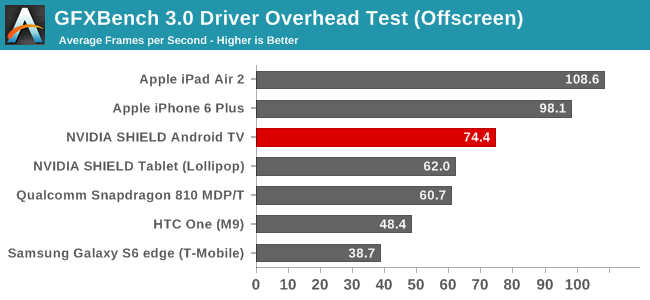
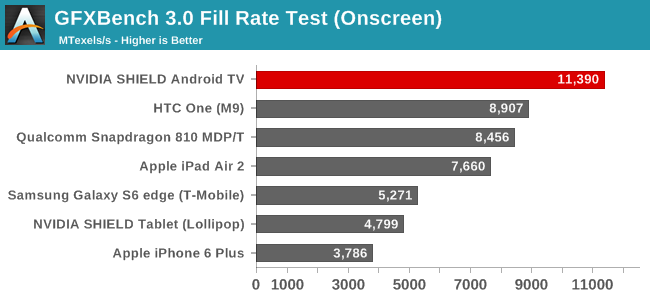
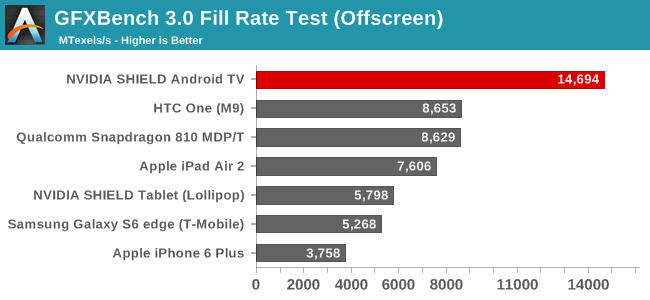
On the last batch of subtests, I’m going to stop again with the fill rate test just to point out another interesting design decision for Tegra X1 and the SHIELD. With NVIDIA banking so much on the set top box’s ability to drive 4Kp60 TVs, NVIDIA needs to push a lot of pixels to get there, as 4K is four-times as many pixels as 1080p. For this reason Tegra X1 is paired with 16 ROPs, giving it low-end PC desktop-like pixel throughput, and of course a huge advantage in the GFXBench fill rate test. And though this fill rate will help with games as well, it’s keeping up with the Android UI at 4Kp60 that is the most important reason for all of this fill rate performance.
Wrapping things up, what else is there to say about the SHIELD Android TV’s GPU performance? What we’re looking at here is twice as fast (or more) than the best phones and tablets today, a combination of the Tegra X1’s very strong GPU design and the set top’s practically unlimited energy and cooling capabilities. Overall NVIDIA is following the path they started long ago on Tegra, always favoring strong GPU performance, leading to the incredible performance we’re seeing here.
With that said, given NVIDIA’s decision to focus on the Android TV aspects of the SHIELD Android TV first and foremost – and not gaming – it’s also fair to say that the SHIELD is overpowered for Android TV work. Other than keeping up with the basic pixel fill needs of 4K, the real power of the box’s GPU is going to be left untapped by Android TV (especially on the ALU side). Which makes all of this humorously absurd in a way, but it’s also why SHIELD Android TV isn’t just an Android TV box. The device’s GPU performance will be put to good use with gaming, though stepping outside the world of benchmarks for a second, the bigger challenge NVIDIA faces is not delivering high performance, it’s delivering games that make full use of that performance.










167 Comments
View All Comments
ganeshts - Thursday, May 28, 2015 - link
From NV: "we do not have an empty HDD bay in the 16GB sku. Users will not be able to add their own HDD into the 16GB sku."ZOONAMI - Friday, May 29, 2015 - link
Wow thank you for prompt reply!Cami Hongell - Thursday, May 28, 2015 - link
Tellybean is the first video call service on Android TV and the SHIELD is the first device that works with a regular Logitech camera. Try it out and please let us know what you think. http://eepurl.com/blSzU9vdek - Thursday, May 28, 2015 - link
How does the performance compare to the XB1 and PS4? Those would seem to be the two immediate competitors for this device. It seems like Anandtech has grown too focused on comparing everything to Tablets/phones...kron123456789 - Thursday, May 28, 2015 - link
"How does the performance compare to the XB1 and PS4?" — It doesn't. This is just hardware:Sheild Android TV — 256 CUDA cores(at ~1GHz), 16ROPs, 16TMUs, 3GB of RAM with 25.6GB/sec bandwidth
Xbox One — 768 GCN cores(at 853MHz), 16ROPs, 48TMUs, 8GB of RAM with 68.2GB/sec bandwidth
PS4 — 1152 GCN cores(at 800MHz), 32ROPs, 72TMUs, 8GB of RAM with 176GB/sec bandwidth
ppi - Thursday, May 28, 2015 - link
Given that basically all TVs now are "smart", what are real advantages of device such as this one over a Smart TV? I am talking video and content playback, of course.While I do not own 4K TV, my 1080p Samsung has no trouble playing HD YouTube and variety of formats from USB disk.
jt122333221 - Thursday, May 28, 2015 - link
More content should be available on Android TV, and it's more likely to be updated than your TVs. Also, there are a lot of people who don't have a Smart TV and who would prefer NOT using their TV's smart features (I despise mine, the interface is horrible, apps are abysmal; only reason I have it is because it came with the TV I wanted).Yojimbo - Thursday, May 28, 2015 - link
I have a Samsung smart tv and it's slow, slow, slow.jeffkibuule - Thursday, May 28, 2015 - link
When's the last time your TV got a meaningful software update?TheJian - Friday, May 29, 2015 - link
You did see the gaming benchmarks right? If that wasn't a major point for the user, not sure why you would pay for this here other than playing all kinds of formats from your USB drives (flash etc), across the network (smart tv's usually not good at that either). Not to mention Grid gaming, which eliminates much of the need for a high end PC and constantly buying $60 games (be it console or PC).You have to be looking at this for more than just vids I think. IE you can do anything android devices can do. Meaning play their games, browse the web etc. I can sit on the couch and browse with a keyboard and mouse with this and a big screen (saving me a fat foot after 8hrs at work and some home time also on top). Too bad anandtech didn't bother to use it like this and comment.
I think SMART tv's are actually pretty stupid. They basically can stream some crap from netflix, youtube, amazon etc and not much more. Now if your tv has roku built-in or something, ok maybe sort of smarter but even that lacks major formats (really just has far more channels than smart tv's). My roku 2/3's are useless for USB sticks on about 80% of my content. I end up sticking it in the bluray player instead as most of the time it either can't play the audio or can't play the video.
If all you're after is movies and some streaming, I'd probably rather have a bluray player for $79-$99 that plays almost all formats from USB and streams fine, not to mention playing all disc formats (LG, BP350 $79 or something). Or even just a roku2 (new model with faster chip or roku 3 if using headphones in remote is needed) if just after streaming stuff but again, from usb sucks here, so I'm just talking web streaming vids.